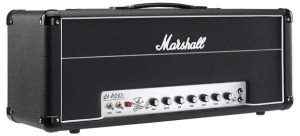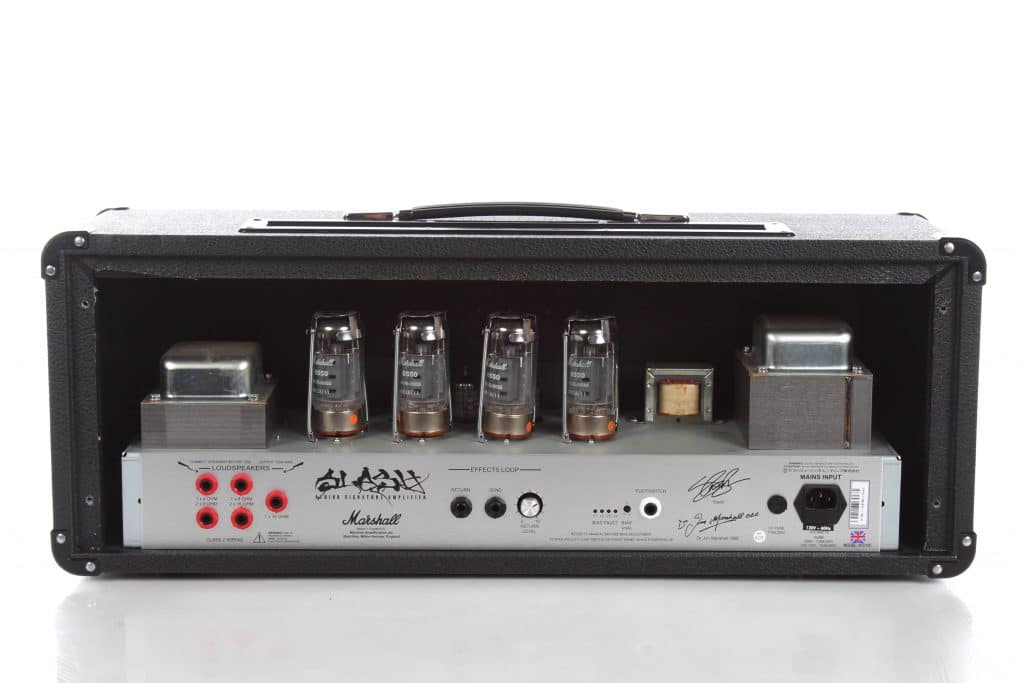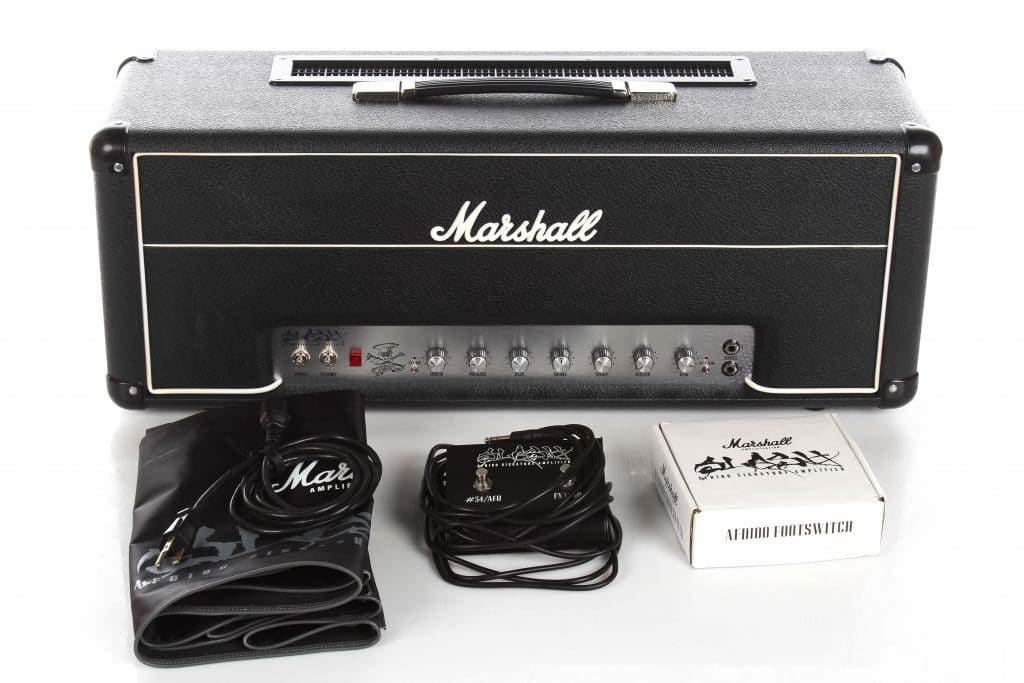The details of Slash’s ‘Appetite’ amp are unknown, but an undaunted Marshall has released a 100W signature head with some eyebrow-raising features. Below you will learn about Marshall AFD100.
What do we know about Slash? He was born in London, he grew up in Stoke, he wears a top hat and his name is another word for a wee–wee. More significantly, we know that in the mid-‘80s he joined an LA rock band called Guns N’Roses, whose debut album Appetite For Destruction turned them into epoch–defining stars and their shaggy lead guitarist into something of an icon.

Slash got his own signature Marshall in 1996, and that would be a nice place to end our story, but there are other things we don’t know so much about. We don’t know for sure what guitar or amp he used on that 28-million-selling record – whose thick, searing lead tones are generally considered to be something of a landmark. This, with a little help from the internet, is how myths begin.
We do know the guitar was a US-made copy of a late-’50s Les Paul. Gibson released a replica of the replica last year and it went down well. The Marshall, however, is more tricky. It was a hire amp; nobody knows where it ended up, and Slash himself seems unsure of precisely what it was. The current thinking seems to favour a modified mid-’70s 1959 model, so that’s what has been used as the basis of the long-awaited Appetite For Destruction signature head, designed in collaboration with Slash himself. Also included is a second ‘mode’, known as #34, which knocks out the Appetite amp’s extra gain stage and aims for a tone closer to the modded JCM800 he’s been using since.
Marshall AFD100 Controls
Table of Contents
Lifting off the padded dustcover, we’re presented with a full-size head in the classic Marshall style with a mean, monochrome look. The silver panel has Slash’s doodle on the left and skinny gothic lettering that recalls the original album artwork.

There are toggle switches at either end for engaging the FX loop and hopping between modes. And the other newcomer on the panel is a Power control, which acts as a second master volume using what Marshall calls ‘Electronic Power Attenuation’ – reducing voltages within the circuit to lower the output to as little as 0.1W. It turns like a standard pot but actually goes through 20-odd stepped settings, which have no relation to the 11 dot markers around it. Surely a series of indents, with the wattages marked on the panel, would have been more user-friendly? The back panel has sockets for the footswitch and FX loop. Plenty of speaker output options, two autographs (Slash’s on top, Jim Marshall’s below). And some slightly alarming bias-related business that we’ll come to in a sec.
Four small machine screws, held by metal inserts in the side battens, keep the back cover in place. Behind it lie four 6550 valves and fi ve ECC83s, all Marshallbranded. Removing some chunkier screws will allow us a peek beneath the chassis. A and here we’re greeted by a veritable meadow of green. One large PCB runs virtually from tranny to tranny (both Dagnalls), and all nine valve bases are mounted directly onto it. There are four smaller boards connected to that by a tidy explosion of blue wires. No vintage pretensions here.
Sounds
Hang on, we have to wait three minutes before we can hear it. The biasing, you see. Marshall recommends that, having fine-tuned the desired current using the trimpot on the back panel. With reference to the chart in the manual. You go through the self-biasing procedure every time you power up the AFD100. It’s simple enough: just hold down the FX loop switch while switching on and let go once the LED flashes.
Then hang around for a bit, perhaps arranging your plectrums in order of thickness, until the amp rumbles into life. Allowing us to do our own bias adjustment may not seem like a wise move. But it does facilitate easy power valve changes between anything from KT88s to EL34s to 6L6s. And if the chart’s anything to go by, you can keep the trimpot set around 36mA and it’ll be safe for all of them. Amp techs are cordially invited to write in and tell us whether this is a great idea or sheer madness.
Once the amp is ready to join us, in the default AFD mode with attenuator fully bypassed and a suitably formidable Marshall AFD100 4×12″ cab plugged in. The slavering hounds of rock hell are quickly off the leash. There’s a fair old noise floor with everything just past noon.
Sound settings
Slash’s favourite setting, apparently – but the main reason for that is that an overdriven all-tube 100W Marshall AFD100 through a 4×12″ is very, very loud. In this case it’s also surprisingly harsh and spiky – even with humbuckers you’ll be leaping for the Presence control and jamming it to zero. It’s a strident lead tone that will certainly cut through a mix, but it’ll also cut through masonry. Both preamp and output levels are happier the higher they go. And if you do manage to get those hounds back on the leash for a few seconds, you’ll find your rewards in the area where sustain turns into musical feedback.
Customization Marshall AFD100
Switching to #34 mode, the tone thins out and gets even more vicious. The interactive controls offer ample scope for mid-scooping. But there’s only so much you can do with EQ, and single notes in the middle register are accompanied by a slight scratchy rumble. Subtlety, by the way, is not an option. In AFD mode we’re promised ‘biting bright cleans’ as well as the heavy stuff, but you’ll find cleaner than this in a dung beetle’s laundry basket.

Now then, the attenuation thing. Starting at minimum, we still have a definite rock voice but the snarly edge has been replaced by a soft fuzziness. Maybe too soft, and that Presence knob will soon be on its way back up again to replace some top-end bite. Now turn the output level up a notch or two and Presence will need to come down again accordingly. It’s quite a balancing act. The AFD is never entirely convincing as a 1W or 12W amp, but it’s not bad. And this is undeniably a useful feature in the age of the home-recorded hit.
Verdict
Setting aside the mythology and the years of internet hype, this doesn’t feel like the holy grail of rock tone. There’s plenty of scope for screeching high-gain heroics, and to be fair, until the original Appetite amp turns up there’s. No way of telling how well Marshall AFD100 has nailed the job in hand. But it’s safe to say they aimed to make it sound fairly nasty, and it may be that they succeeded a little too well.

Leave a Reply
You must be logged in to post a comment.